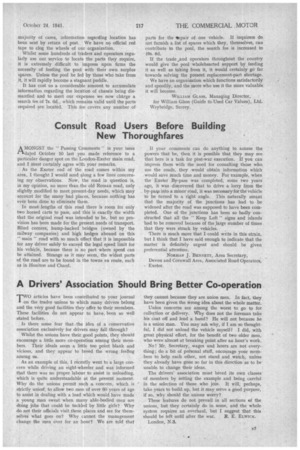Consult Road Users Before Building New Thoroughfares
Page 25

If you've noticed an error in this article please click here to report it so we can fix it.
AMONGST the "Passing Comments" in your issue dated October 10 last you made reference to a particular danger spot on the London-Exeter main road, and I must certainly agree with your remarks.
As the Exeter end of the road comes within my area, I thought I would send along a few lines concerning my observations. Now, the road in question is, in my opinion, no more than the old Roman road, only slightly modified to meet present-day needs, which may account for the many bad places, because nothing has ever been done to eliminate them.
In most lengths of this road there is room for only two horsed carts to pass, and this is exactly the width that the original road was intended to be, but no provision has been made for the present needs of transport. Blind corners, hump-backed bridges (owned by the railway companies) and high hedges abound on this " main" road with so much effect that it is impossible for any driver safely to exceed the legal speed limit for his vehicle, because there is no part where speed can be attained. Strange as it may seem, the widest parts of the road are to be found in the towns en route, such as in Hon iton and Chard. If your comments can do anything to arouse the powers that be, then it is possible that they may see that here is a task for post-war execution. If you can impress them with the need for consulting those who use the roads, they would obtain information which would save much time and money. For example, when the Exeter By-pass was completed, some two year ago, it was discovered that to drive a lorry from the by-pa as into a minor road, it was necessary for the vehicle to be turned to a right angle. This naturally meant that the majority of the junctions has had to be widened after the road was supposed to have been completed. One of the junctions has been so badly constructed that all the " Keep Left" signs and islands had to be removed because of the large number of times that they were struck by vehicles_
There is much more that I,could write in this .strain, but I think that I have said enough to indicate that the matter is definitely urgent and should be given preferential attention.
NORMAN J. BENNETT, Area Secretary, Devon and Cornwall Area, Associated Road Operators, • Exeter.




















































